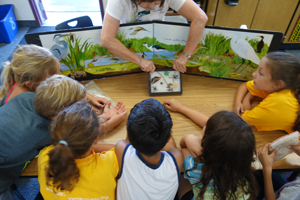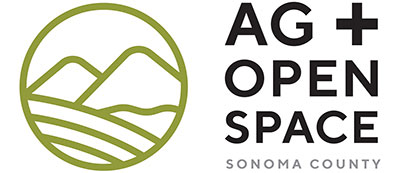Learning Laguna School Program
Program Details • Field Trip • A No Cost Program • Application: 2025-2026 School Year
The Learning Laguna school program offers school children in 2nd-4th grades a chance to learn more about wetlands, the Laguna watershed, and flora and fauna of Sonoma County. The two-part program is offered each fall in September and October and in the spring between mid-March and May. The Learning Laguna curriculum teaches to Next Generation Science Standards and content standards in language arts.
Learning Laguna School Program The program is two-fold: Our goal is to provide a science based curriculum as well as to awaken the children's enthusiasm and senses to the wonders of the natural world.
- A morning of activities in the classroom when the children learn about wetlands and are introduced to the Laguna. A field trip the following week to the Laguna to explore and deepen their understanding and reverence for the natural world.
- Each class is taught by our docents who work with students in small groups. Learning Laguna Docents are well trained in the ecology and lore of the Laguna, environmental education strategies, and effective teaching techniques for working with children.
CLASSROOM VISIT
90-120 minutes based on class size and school schedule. The object of our activities is to build an appreciation for the beauty, uniqueness and importance of the Laguna de Santa Rosa. The classroom activities prepare the students for their field experience by creating interest, excitement and knowledge about the Laguna. After the whole group introduction and slide show, student groups of 5-7 rotate through each docent-run station in 12-15 minute intervals. The number of activity stations depends on class size. INTRODUCTION
& SLIDESHOW
Purpose: To visually acquaint students with the different environments of the Laguna, provide a visual overview of the Laguna during the four seasons of the year, and create enthusiasm about the Laguna and its inhabitants through the introduction of vocabulary and ecological concepts. Activity: Watch slide show, answer and ask questions about the images and concepts.
ANIMAL TRACKS
Purpose:Familiarize students with the variety of wildlife that live in the Laguna watershed. Discuss characteristics and adaptations of animal feet. Introduce concepts of carnivore, herbivore, and omnivore. Activity: After Discussion, each student makes a bookmark using animal track stamps and ink.
WHO AM I?
Purpose: To encourage students to identify characteristics of various wildlife that live in the Laguna. Activity: Students learn identifying characteristics of animal groups, then practice and take turns identifying specific animals using those characteristics.
WETLANDS!
Purpose: To understand what wetlands are, what makes them unique, and their related functions to wildlife habitat, flooding, erosion, and water purification. Activity: Students share observations of an artist rendering of a Laguna wetland cross-section. They are given objects from a wetland to touch and discuss, ranging from birds' nests to seeds, insects, cattail fluff, and pieces of tule. The docent then brings out two physical models of landforms, with and without wetland vegetation adjacent to a creek. Students make predictions about what would happen if a rainstorm dropped water on the landforms, then spray water on the models with squirt bottles to see if their predictions were correct.
BIRD MIGRATION GAME
Purpose: To introduce the concept of migration, why it occurs, the importance of food availability to migrating and resident birds, and the importance of the Laguna for year-round habitat for birds traveling along the Pacific Flyway. Activity: Students play a board game that explores the variety of foods that birds eat, natural environmental events that affect food availability, and a bird's ability to nest or migrate.
BIRD
INVESTIGATION
STATION
This activity is added if the class size exceeds 25 students Purpose: To awaken curiosity about birds and hone observation skills and analytical thinking. To introduce/review the concepts of adaptation and camouflage, nest building, plus relationships between form and function.
Activity: Students investigate a collection of bird skulls, beaks, feathers, nests, and feet to find evidence and answers to relevant questions
Field Trip
The Laguna becomes a living classroom for the students and gives them opportunities to engage their senses in nature. Students experience structured activities where they learn about food webs, adaptations, interconnectedness, and the wetlands' ecosystem services. There is also unstructured time for exploration, hypothesizing, experiential learning, and discovery. The docents always keep their eyes out for "teachable moments" to reinforce concepts taught in the classroom.
At our Aquatic Station, students examine Laguna water and identify some of the aquatic life essential to supporting life both in the water and on the land. Students then test their critical thinking skills while pondering a Laguna void of life.
The Tule activity allows each student to use plant material to weave a toy in the likeness of a wetland bird, the American Bittern. Additionally, students learn how the Laguna and its lands have supported people for thousands of years by providing food, fertile soil, and tools of everyday living.
At the Mammal Station, children examine wild animal pelts up close and discuss camouflage and warning colors.
The Alone Walk gives children time to slow down and quietly notice the sights and sounds surrounding them.
During the field trip, children use binoculars and spotting scopes to watch Cliff Swallows build their mud nests, Western Pond Turtles basking on logs, and ducklings taking their first paddle. Students enjoy using magnifiers to investigate tiny holes and the interesting spiders and insects that always capture their attention and imagination. They become wildlife detectives, discovering evidence of river otters, raccoons, owls, and many other species of animals and plants. Throughout the field experience, docents do not simply tell students facts about what they are noticing. Instead, docents ask the students questions to deepen observation skills and help them make cognitive and emotional connections.
Field trips occur in the morning from 9:15 am to 12:15 pm at either the Laguna Uplands Preserve (spring) or the City of Santa Rosa's Stone Farm (fall). Both properties are along the Laguna de Santa Rosa.
A No Cost Program for Schools
Learning Laguna is offered in partnership with Sonoma County Ag+Open Space. There is no charge for these programs, which is made possible by the voters of Sonoma County who fund the work of Ag + Open Space with a quarter-cent sales tax. Bus transportation scholarships are available. ___________________________________
For more information, contact Christine Fontaine, Education Director
by email or by calling 707.527.9277 xt 102[ top ]
. Banner Image by Dana Vallarino


